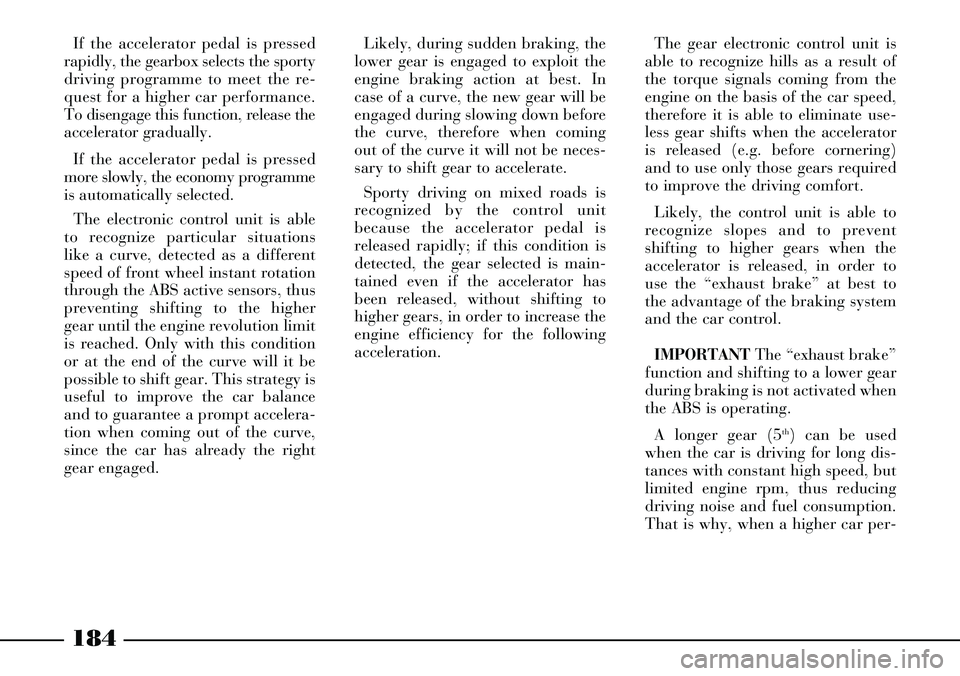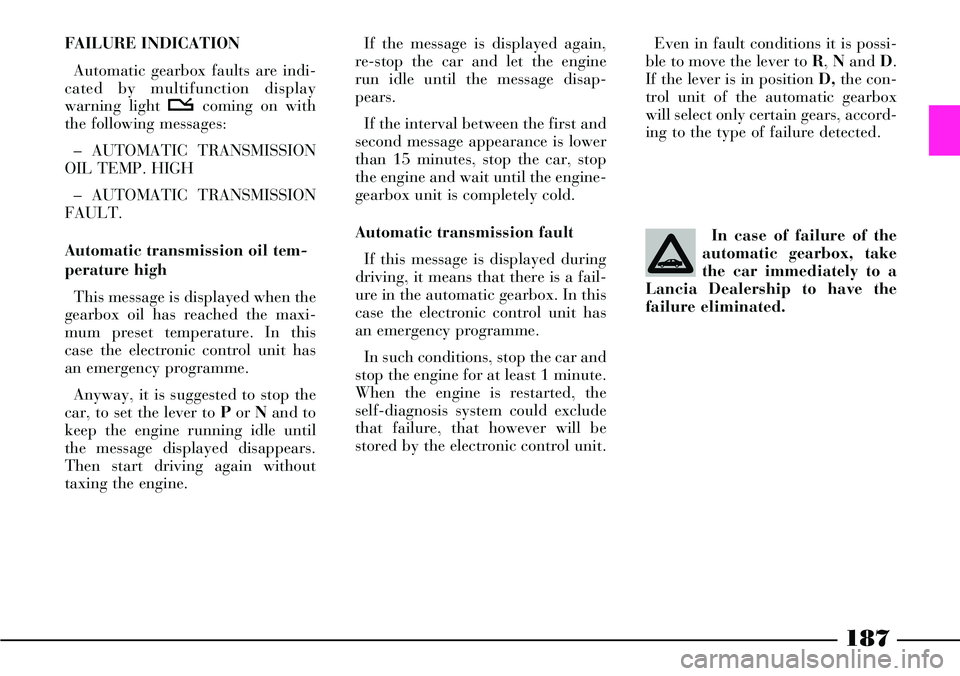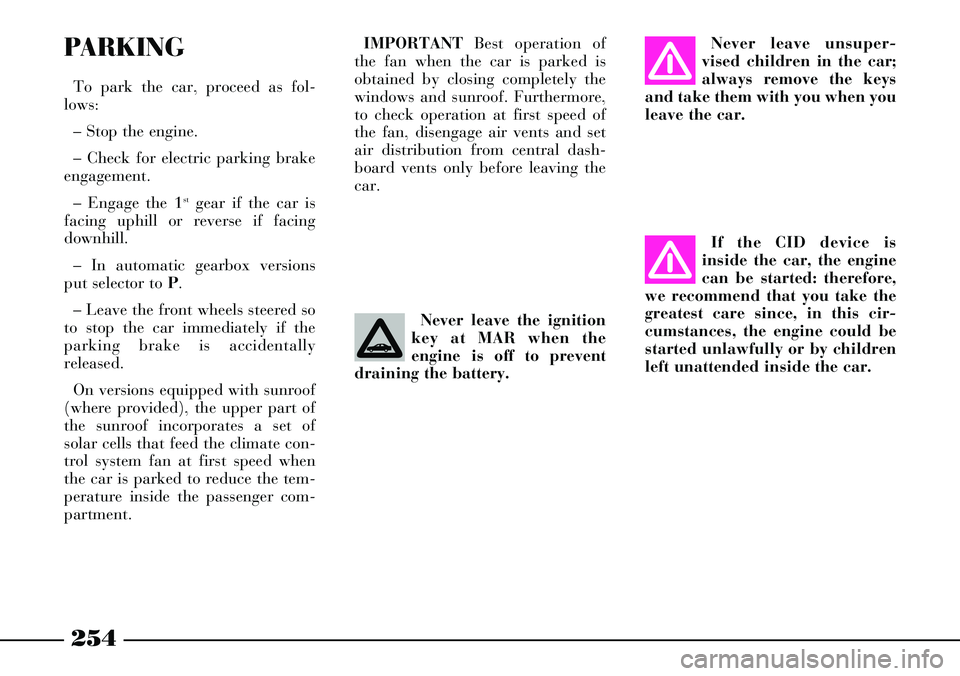gearbox Lancia Thesis 2007 Owner handbook (in English)
[x] Cancel search | Manufacturer: LANCIA, Model Year: 2007, Model line: Thesis, Model: Lancia Thesis 2007Pages: 386, PDF Size: 8.69 MB
Page 184 of 386

183
R - Reverse
Shift the lever to Rwith the car
stationary, the engine running idle
and the brake pedal pressed.
When the lever is at Rbackup
lights turn on and a buzzer will
sound for about 4 seconds to warn
other people that reversing is in
progress.
IMPORTANTEven with the lever
in position R, the reverse gear can-
not be engaged if the car speed is
higher than the established value.
When the speed is reduced, the
reverse gear can be engaged and it
remains engaged even if the car
speed overcomes that limit.N - Neutral
This is the position to be used when
the car must be pushed or towed.
D - Forward gear (automatic)
This is the position to be used when
all automatic gearbox functions are
required.
The electronic control unit controls
that the five gears are engaged auto-
matically according to car speed,
engine rpm, accelerator pedal posi-
tion and pressing speed, together
with the main driving conditions
such as hills, slopes, curves and
braking.
Indeed, the electronic automatic
gearbox is able to choose, according
to the type of driving adopted by the
driver, different programmes subdi-
vided into comfortable driving,
economy driving and sporty driving,
with shift points ranging between
low and high. Before leaving the car,
check that the electric
parking brake (EPB) is
on. Shift the lever to position P
even when the car is left with the
engine running.
In case of emergency (failures, flat
battery, etc.), it is possible to shift
the lever from position Pto N, D or
Rby pressing lever A(fig. 141) set
under the gear lever mask. To reach
the lever, remove the press-fit odd-
ment compartment shelf Bin front
of the gearshift lever.
fig. 141
L0A0276b
Page 185 of 386

184
If the accelerator pedal is pressed
rapidly, the gearbox selects the sporty
driving programme to meet the re-
quest for a higher car performance.
To disengage this function, release the
accelerator gradually.
If the accelerator pedal is pressed
more slowly, the economy programme
is automatically selected.
The electronic control unit is able
to recognize particular situations
like a curve, detected as a different
speed of front wheel instant rotation
through the ABS active sensors, thus
preventing shifting to the higher
gear until the engine revolution limit
is reached. Only with this condition
or at the end of the curve will it be
possible to shift gear. This strategy is
useful to improve the car balance
and to guarantee a prompt accelera-
tion when coming out of the curve,
since the car has already the right
gear engaged.Likely, during sudden braking, the
lower gear is engaged to exploit the
engine braking action at best. In
case of a curve, the new gear will be
engaged during slowing down before
the curve, therefore when coming
out of the curve it will not be neces-
sary to shift gear to accelerate.
Sporty driving on mixed roads is
recognized by the control unit
because the accelerator pedal is
released rapidly; if this condition is
detected, the gear selected is main-
tained even if the accelerator has
been released, without shifting to
higher gears, in order to increase the
engine efficiency for the following
acceleration. The gear electronic control unit is
able to recognize hills as a result of
the torque signals coming from the
engine on the basis of the car speed,
therefore it is able to eliminate use-
less gear shifts when the accelerator
is released (e.g. before cornering)
and to use only those gears required
to improve the driving comfort.
Likely, the control unit is able to
recognize slopes and to prevent
shifting to higher gears when the
accelerator is released, in order to
use the “exhaust brake” at best to
the advantage of the braking system
and the car control.
IMPORTANTThe “exhaust brake”
function and shifting to a lower gear
during braking is not activated when
the ABS is operating.
A longer gear (5
th) can be used
when the car is driving for long dis-
tances with constant high speed, but
limited engine rpm, thus reducing
driving noise and fuel consumption.
That is why, when a higher car per-
Page 186 of 386

185
Winter programme
When starting to drive with a
reduced road grip (snow-covered,
icy road, etc.), the shift control unit
automatically engage the “ICE” pro-
gramme.
This programme allows starting
with the 2
ndgear engaged, in order to
improve the gear shift efficiency
according to grip conditions.
“ICE” programme activation is
possible only when the gear lever is
at D. If the lever is in the sequential
gear sector, the gear engaged at the
moment of moving off is always that
selected by the driver.
When the “ICE” programme has
been activated, Kickdown is not
operating.Kick down
When maximum acceleration is
required (e.g. during overtaking), if
the accelerator is rapidly and fully
depressed, lower gears are automat-
ically engaged, provided the engine
rpm enable this operation.
Later, when the accelerator pedal
is released, the gear engaged is
selected according to the type of dri-
ving and the position of the acceler-
ator.
Kick-down can be engaged only
when the gear lever is at D.
IMPORTANTIt is suggested to use
Kick-down only when required, e.g.
during overtaking, to limit the fuel
consumption.
When the engine is run-
ning idle and the lever is
at D, the car starts moving
even if on a flat ground: keep the
brake pedal pressed until moving
off. formance is requested in terms of
acceleration and maximum speed,
this gear is almost never selected.
The electronic automatic gearbox
is fitted with a device reducing
inside gearing dragging when the car
is stationary and the brake pedal
depressed. The advantages of such a
function are a considerable noise
reduction, with consequent vibra-
tion reduction and limited fuel con-
sumption.
Page 187 of 386

186
MANUAL SEQUENTIAL
OPERATION
To use the manual sequential oper-
ation move the lever to the two-posi-
tion left sector (fig. 137):
(+) = higher gear
(–) = lower gear.
Shifting to the manual sequential
sector is possible only from position
D: the gear automatically selected
when the lever is moved will remain
engaged.
It is possible to pass to the gear
manual sequential control in any
driving condition.
To engage a higher gear, move the
lever to (+) and to shift a lower gear
move the lever to (–).IMPORTANTIf gear shift gener-
ates a runaway speed rate, such gear
is cancelled by the electronic control
unit and the driver is warned by a
buzzer and by the engaged gear
flashing on the instrument panel dis-
play.
When the manual
sequential operation is
set, gears shall be shifted
manually, as for versions with the
traditional manual gearbox. Only
when the car stops the gear auto-
matically engaged is the first one.If the lever is brought back to Dthe
gearbox immediately starts to work
automatically and will be engaged
according to the type of driving
selected.
IMPORTANTThe electronic con-
trol unit is programmed to shift one
gear at a time, therefore rapid and
repeated actions do not correspond
to rapid and repeated gear engaging.
A higher or lower gear is engaged by
shifting the lever to position (+) or
(–) after the previous request has
been realized.
In case of failure of the manual
sequential system, the electronic
control unit will select the automatic
operation.
Page 188 of 386

187
Even in fault conditions it is possi-
ble to move the lever to R, Nand D.
If the lever is in position D,the con-
trol unit of the automatic gearbox
will select only certain gears, accord-
ing to the type of failure detected.
In case of failure of the
automatic gearbox, take
the car immediately to a
Lancia Dealership to have the
failure eliminated.FAILURE INDICATION
Automatic gearbox faults are indi-
cated by multifunction display
warning light tcoming on with
the following messages:
– AUTOMATIC TRANSMISSION
OIL TEMP. HIGH
– AUTOMATIC TRANSMISSION
FAULT.
Automatic transmission oil tem-
perature high
This message is displayed when the
gearbox oil has reached the maxi-
mum preset temperature. In this
case the electronic control unit has
an emergency programme.
Anyway, it is suggested to stop the
car, to set the lever to Por Nand to
keep the engine running idle until
the message displayed disappears.
Then start driving again without
taxing the engine.If the message is displayed again,
re-stop the car and let the engine
run idle until the message disap-
pears.
If the interval between the first and
second message appearance is lower
than 15 minutes, stop the car, stop
the engine and wait until the engine-
gearbox unit is completely cold.
Automatic transmission fault
If this message is displayed during
driving, it means that there is a fail-
ure in the automatic gearbox. In this
case the electronic control unit has
an emergency programme.
In such conditions, stop the car and
stop the engine for at least 1 minute.
When the engine is restarted, the
self-diagnosis system could exclude
that failure, that however will be
stored by the electronic control unit.
Page 189 of 386

188
If the failure is signalled when the
engine is started, it means that the
electronic control unit had stored it
previously, before stopping the
engine. Even in this case, go to a
Lancia Dealershipto have the
automatic gearbox checked.
When driving with auto-
matic gearbox faulty,
drive carefully consider-
ing the limited car efficiency in
terms of acceleration and speed.
In addition, when driving with
automatic gearbox faulty, the
reverse block might not be oper-
ating: for this reason it is
absolutely necessary to move the
lever to position R while the car
is moving.SOUND SIGNAL
A buzzer will sound in the follow-
ing conditions:
– for about 15 seconds when the
driver’s door is opened while the
engine is running or not and the gear
lever has a position different from P
– for about 15 seconds when the
engine is turned off and the gear
lever has a position different from P
– for about 4 seconds when the
gear lever is shifted to R(reverse)
– with the manual sequential oper-
ation on, when the selected gear is
not accepted by the electronic con-
trol unit (e.g. since it might generate
a runaway speed rate). BUMP STARTING
Never bump starting the engine (by
pushing, towing, etc.). In an emer-
gency, when the battery is flat, start
the engine with the appropriate
emergency battery according to the
instructions contained in chapter “In
an emergency”.
Page 190 of 386

189
If these rules are not
respected, the automatic
gearbox might be severely
damaged.
The car can be towed only for
short distances and at a low
speed: if it is necessary to tow it
for a longer distance, raise the
driving wheels so that the gear-
box is not dragged during towing. TOWING THE CAR
IMPORTANTTo tow the car
observe local current laws and fol-
low the instructions contained in
chapter “In an emergency”.
If the car must be towed, observe
the following precautions:
– if possible, transfer the car on a
towtruck
– otherwise, tow the car by raising
the front driving wheels
– even if the latter solution is not
possible, the car can be towed for
less than 50 Km at a speed of 50
km/h.
Towing shall be performed with
gear lever to N.Before starting towing,
disengage the parking
brake as described in the
relevant paragraph and leave the
Keyless System CID (if any) in the
passenger’s compartment to pre-
vent automatic steering lock. Do
not tow the car with the engine
running.
ESP AND ASR
SYSTEMS
ESP SYSTEM (ELECTRONIC
STABILITY PROGRAM):
GENERAL
ESP is an electronic system con-
trolling the car stability which
affects the driving torque and brakes
the wheels in a different way in case
of grip loss, thus making the car
recover the right driving direction.
During driving the car is subject to
side and longitudinal forces which
can be controlled by the driver until
tire grip is acceptable. When the lat-
ter is lower than the minimum level,
the car starts skidding.
If the road bed is uneven (bumpy
road, presence of ice, mould, etc.)
tyre grip is considerably reduced. In
these conditions, when extreme
manoeuvres are made, the car might
start skidding.
Page 252 of 386

251
HOW TO START PETROL
VERSIONS
IMPORTANTNever press the
accelerator before the engine has
started.
1) Ensure that the electric parking
brake is on (instrument panel warn-
ing light xon).
2) Ensure that electrical systems
and devices, especially high absorp-
tion ones (e.g. heated rear window),
are off.
3) On versions with manual gear-
box, set the gear lever to neutral and
press the clutch pedal fully down to
avoid the starter dragging the gears.4) On versions with electronic
automatic gearbox, ensure that the
selector is at Pand keep the brake
pedal pressed.
5) Turn the ignition key to AVV
and release it as soon as the engine
starts.
6) If the engine fails to start, return
the key to STOPand repeat the pro-
cedure.
IMPORTANTIf the engine does
not start at the first attempt, do not
keep turning the ignition key to
avoid damaging the catalyst.
Contact a Lancia Dealership.HOW TO START JTD VERSIONS
1) Ensure that the electric parking
brake is on (instrument panel warn-
ing light xon).
2) Put the gear lever to neutral.
3) Turn the ignition key to MAR.
4) Wait until the mwarning light
is off: the hotter the engine is, the
quicker this will happen.
When the engine is particularly hot
the warning light may come on so
quickly that it is impossible to notice
it.
5)Press the clutch pedal down to
the floor.
6) Turn the ignition key to AVV
immediately after the mwarning
light goes out. If you wait too long,
you will lose the benefit of the work
done by the glow plugs.
Page 253 of 386

252
IMPORTANTEnergy-absorbing
devices (climate control system,
heated rear window etc.) are auto-
matically disconnected at starting.
If the engine does not start at the
first attempt, return the ignition key
to STOPbefore trying to start the
engine again.
If starting is particularly diffi-
cult,(with the Lancia CODE system
working properly) do not keep try-
ing too many times.
Use an auxiliary battery only if the
battery has insufficient charge.
Never use a battery charger to start
the engine. ENGINE WARMING UP
– Begin to move forward slowly let-
ting the engine turn at medium revs.
Do not accelerate abruptly.
– Do not push the engine to its limit
for the first few kilometers. You are
recommended to wait until the
coolant temperature has reached 50
to 60 °C.STOPPING THE ENGINE
– Release the accelerator pedal and
wait until the engine is idling.
– Turn the ignition key to STOP
and turn the engine off. For versions
with electronic automatic gearbox,
put the selector to Pbefore turning
the engine off.
IMPORTANTAfter a taxing drive
you should allow the engine to
“catch its breath” before turning it
off by letting it idle to allow the tem-
perature in the engine compartment
to fall.
Page 255 of 386

254
Never leave unsuper-
vised children in the car;
always remove the keys
and take them with you when you
leave the car.
If the CID device is
inside the car, the engine
can be started: therefore,
we recommend that you take the
greatest care since, in this cir-
cumstances, the engine could be
started unlawfully or by children
left unattended inside the car.PARKING
To park the car, proceed as fol-
lows:
– Stop the engine.
– Check for electric parking brake
engagement.
– Engage the 1
stgear if the car is
facing uphill or reverse if facing
downhill.
– In automatic gearbox versions
put selector to P.
– Leave the front wheels steered so
to stop the car immediately if the
parking brake is accidentally
released.
On versions equipped with sunroof
(where provided), the upper part of
the sunroof incorporates a set of
solar cells that feed the climate con-
trol system fan at first speed when
the car is parked to reduce the tem-
perature inside the passenger com-
partment.Never leave the ignition
key at MAR when the
engine is off to prevent
draining the battery.
IMPORTANT Best operation of
the fan when the car is parked is
obtained by closing completely the
windows and sunroof. Furthermore,
to check operation at first speed of
the fan, disengage air vents and set
air distribution from central dash-
board vents only before leaving the
car.